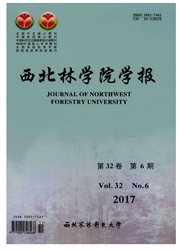

 中文摘要:
中文摘要:
通过测定比较2种基质下引种樟子松(Pinus sylvesiris var.mongolica)的光合特性,研究移栽1a后的樟子松对本地土壤的适应性,为樟子松的引种培育以及在本区的推广提供依据。结果表明,灌水后2d内2种基质的土壤体积含水量有显著差异,土壤温度和电导率无显著差异;施肥沙土组的净光合速率(Pn)和水分利用效率(WUE)极显著高于配制基质组,按照Pn对光合有效辐射(PAR)的定积分,施肥沙土组高于配制基质组(22.32〉14.74),按照WUE对PAR的定积分,施肥沙土组亦高于配制基质组(10.18〉7.09);生物量方面,施肥沙土组也极显著高于配制基质组。
 英文摘要:
英文摘要:
In order to provide scientific basis for the introduction and cultivation,as well as extension of P. sylvesiris to Karamay,Xinjiang, adaptabilities of P. sylvesiris seedlings one year after transplantation were studied by measuring and comparing photosynthetic characteristics in two matrixes (fertilized sandy soil, FSS, and formulated soil, FS). Significant differences were observed in soil volumetric moisture content between two matrixes. No significant differences were found in soil temperature and electric conductivity. The rate of net photosynthesis (Pn) and water use efficiency (WUE) in FSS group were significantly higher than those of FS group. The integral value of Pn to photosynthetically active radiation (PAR) in FSS group was higher (22.32) than FS group (14.74),while the integral value of WUE to PAR in FSS group was higher (10.18) than FS group (7.09). The biomass of FSS group was also significantly higher than that of FS group.
 同期刊论文项目
同期刊论文项目
 同项目期刊论文
同项目期刊论文
 Variations in Ecosystem Service Value in Response to Oasis Land-use Change in Keriya Oasis, Tarim Ba
Variations in Ecosystem Service Value in Response to Oasis Land-use Change in Keriya Oasis, Tarim Ba Source identification and hazardous risk delineation of heavy metal contamination in Yanqi Basin, no
Source identification and hazardous risk delineation of heavy metal contamination in Yanqi Basin, no 期刊信息
期刊信息
